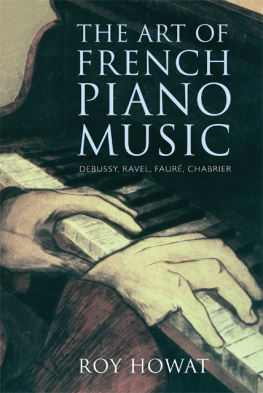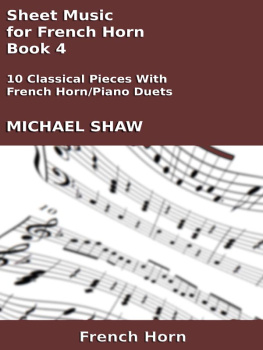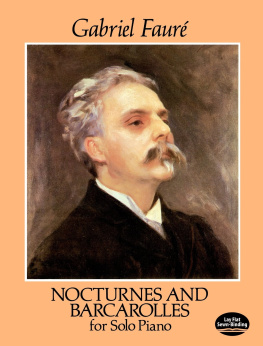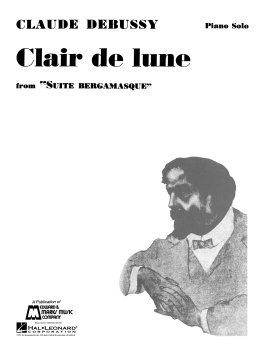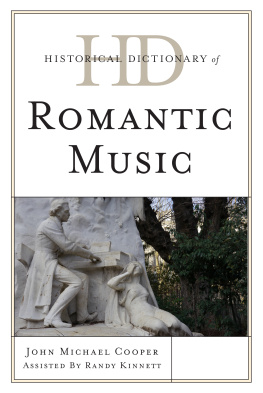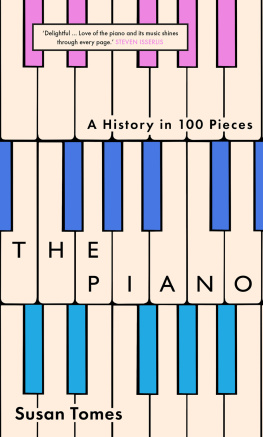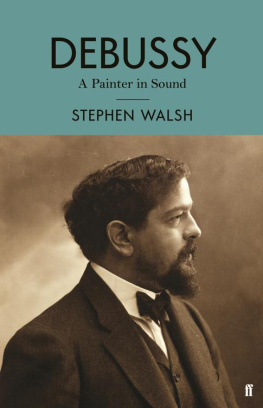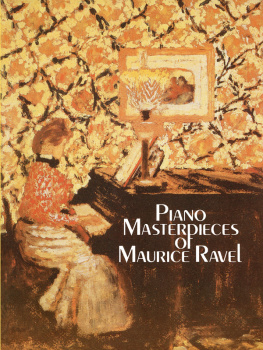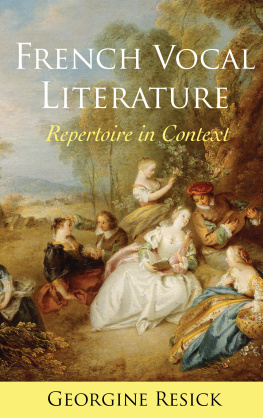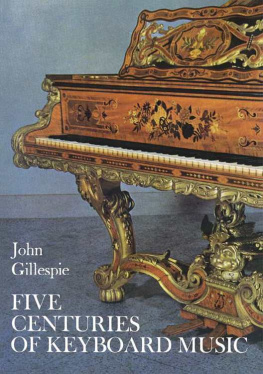THE ART OF FRENCH PIANO MUSIC
DEBUSSY, RAVEL, FAUR, CHABRIER
for Emily,
for all those who, over the years,
encouraged me to write this book,
and in fond remembrance of Peter Platt

Copyright 2009 by Roy Howat
All rights reserved. This book may not be reproduced in whole or in part, in any form (beyond that copying permitted by Sections 107 and 108 of the U.S. Copyright Law and except by reviewers for the public press), without written permission from the publishers.
For information about this and other Yale University Press publications please contact:
U.S. Office:
Europe Office:
Set in Minion by J&L Composition Ltd, Filey, North Yorkshire
Printed in Great Britain by MPG Books Ltd., Bodmin, Cornwall
Library of Congress Control Number 2009920775
ISBN 978-0-300-14547-2
A catalogue record for this book is available from the British Library
10 9 8 7 6 5 4 3 2 1
C ONTENTS
I LLUSTRATIONS
Plates
Figures
je sauray tojours gr ceux qui, par un art infini soutenu par le got, pouront ariver rendre cet instrument susceptible dexpression
Franois Couperin (1er Livre de Pices de clavecin)
A CKNOWLEDGMENTS
T O list all those who helped make this book happen could fill a book in itself, and I beg forgiveness for any inadvertent omissions. Inspiring teachers whose insights have indelibly marked me only a few of them are still among us include Ken Hetherington, Frank Spedding, Sir David Willcocks, Philip Radcliffe, Ian Kemp, Wight Henderson, Michael Gough Matthews, Jacques Fvrier, Vlado Perlemuter, Nina Walker, Brigitte Wild, and Igor Hmelnitsky. To these last three in particular, along with the late Jean Gibson, I owe much of my freedom and technique at the piano; to Ian Kemp I am grateful for the scholarly guidance that helped shape my first book, Debussy in Proportion; to George Caird, Sarah Verney Caird and Mary Verney I am ever-thankful for directing me to Perlemuter. As a chamber music coach, the late Miles Coverdale left an unforgettable imprint of the wit, lan and sophistication of Faurs music; only now does it strike me what a role this played in prompting the present . Unforgettable stimulus came from my time working with the late Peter Platt at the University of Sydney; never will I forget the animation and focus of our many musical sessions and conversations. And how lucky I was to grow up with music-loving parents and my tolerant sister Helen, with all of whom I enjoyed playing duets. My francophile mother had me chirping a few words of French even before I tried my first notes on the piano; she later started me on the violin, setting off many years of string playing that make me automatically think orchestrally at the piano.
Sympathetic fellow-researchers have made French music a doubly enjoyable field of work, in which special gratitude goes to an informal club des francophiles across the world (and their many publications), including Kenneth van Barthold, Joan Booth, Sidney Buckland, Katharine Ellis, Neil Heyde, Robin Holloway, Barbara Kelly, Hugh Macdonald, Deborah Mawer, Roger Nichols (who, with Philip Radcliffe, first spurred my Chabriophilia), Robert Orledge, Caroline Potter, Caroline Rae, John Rink, Paul Roberts, Lucy Robinson, Jim Samson, John Sidgwick, Jeremy Siepmann, Nigel Simeone (who, along with Charles Timbrell and Donald Dixon, talked me into writing this book), Richard Langham Smith, Simon Trezise, John York; Elliott Antokoletz, James Briscoe, Bruce Brubaker, Carlo Caballero, Tim Carter, Annegret Fauser, Gail and Jacques Delente and many participants at the French Piano Institute, Mark DeVoto, David Grayson, Julia Hennig, Ken Johansen, Sylvia Kahan, Cathy Kautsky, David Korevaar, Philip Lasser, Bennett Lerner, Robert Levin, Ralph Locke, Mark McFarland, Julian Martin, Scott McCarrey, Gwendolyn Mok, Nancy Nicholson, Arbie Orenstein, Jann Pasler, Tom Plaunt, Sabina Ratner, Marie Rolf, J.-Y. Song, Arthur Wenk, Marianne Wheeldon, Lesley Wright; Michael Christoforidis, Deborah Crisp, Terence Dennis, Helen Kasztelan, Elizabeth Kertesz, Heath Lees, Julia Lu, Kerry Murphy, Deborah Priest, Nicholas Routley, Shirley Trembath, Tams Vesmas and David Tunley, along with others listed in particular contexts below; and the late Felix Aprahamian, William Austin, Elaine Brody, Douglass Green, Paul Jacobs and Grant Johannesen. Several of us from that musical list were first brought together by Margaret G. Cobb, doyenne of Debussy research and founding animatrice in the early 1970s of the Centre de Documentation Claude Debussy, who continues to inspire us all. Keith and Frances Moffat have my gratitude for their hospitality during many research visits to New York.
In continental Europe encouragement, information and practical help have come from Jean-Franois Antonioli, Rgis and Catherine dAvezac, Marcel Bitsch, Thierry and Pierrette Bodin, Narcis Bonet, Pierre Boulez, Antony and Sheila Brown, Marie-France Calas, Philippe Cassard, Nria Cunillera Salas, Jean Claude Darcey, Micheline and the late Roger Delage; Michel Denis, Philippe Dinkel, Sylvie Douche, Jean-Jacques Eigeldinger, Henri Garus, Judith Gentil, Jay Gottlieb, Nina Gubisch-Vies (for access to the diaries of her great-uncle Ricardo), Carles Guinovart, Charles Guy, Nancy Harper, Eric Heidsieck, Denis Herlin, Philippe Junod, Cyprien Katsaris, Henri-Louis de La Grange, Joe Laredo, Claire Launchbury, Eric Van Lauwe, Ccile Leblanc, Nol Lee, Edmond Lematre, Anik Lesure-Devris and the late Franois Lesure; Alain Louvier, Marcel Marnat, Glade Masselot, Olivier Mazal, Dominique Merlet, Rachel Moore, Jean-Michel Nectoux, Albert Nieto, Bertrand and Jacqueline Ott, Alain Plans, Gerald Pointon, Alain Poirier, Sbastien Risler, Michel, Sylvie and Solne Romieu, Jane Schmidt, Georges Starobinski, Jacques Tchamkerten, Cecilio Tieles Ferrer, Julian and Margie Todd, Damien Top, Myriam Chimnes and Alexandra Laederich of the Centre de Documentation Claude Debussy in Paris, and Rmi Copin of the Muse Claude Debussy at Saint Germain-en-Laye; and the late Marcel Ciampi, Marius Flothuis, Claude Helffer, Arthur Hore, Eugene Kurtz and Manuel Rosenthal. To the late Germaine Inghelbrecht (widow of D.-E.) I am ever-grateful for introducing me to Debussys stepdaughter Mme Gaston de Tinan, the Dolly of Faurs duet suite. I was lucky to spend many afternoons hearing Mme de Tinans recollections of how her stepfather played his music, and indeed of a whole epoch. For the privilege of playing on Debussys, Ravels and Faurs still-beautiful pianos I am thankful to Claire Moser (Muse Labenche, Brive), Mme Claude Moreau (Muse Maurice Ravel, Montfort lAmaury) and Thierry Maniguet (Muse de la musique, Paris). Expertise on reproducing rolls and pianos came with limitless friendliness and enthusiasm from Denis Hall and Rex Lawson (London), Denis Condon and Robert Mitchell (Sydney) and Ken Caswell (Austin), as well as from Richard Cole of The Musical Museum, Brentford.
Librarians worldwide have facilitated my access to sources, often ingeniously tracking down rare material and spontaneously supplying invaluable leads: in particular I thank the library staff at the Royal College of Music and Royal Academy of Music, London, Richard Andrewes and the Cambridge University and Music Faculty Libraries, Margaret Cranmer and the Rowe Library at Kings College, the British Library, the Bibliothque nationale de France (under its music curator Catherine Massip) and the Mdiathque Mahler in Paris, the Mdiathque Hector Berlioz at the Paris Conservatoire, the Abbaye de Royaumont (Marie-Christine Daudy and the late Isabelle Goun), the Conservatoire de Genve, J. Rigbie Turner and the Pierpont Morgan Library and Museum, New York, the Harry Ransom Center at the University of Texas, Austin (and the late Carlton Lake), and librarians at other universities and conservatoires around the USA, Australia and New Zealand. The insights obtained from musical editing prompt me to acknowledge my many helpful colleagues at Peters Edition and Editions Durand, along with the late Ronald Herder of Dover Publications; extracts from Ravels music are reproduced here by kind permission of Editions Durand.
Next page
